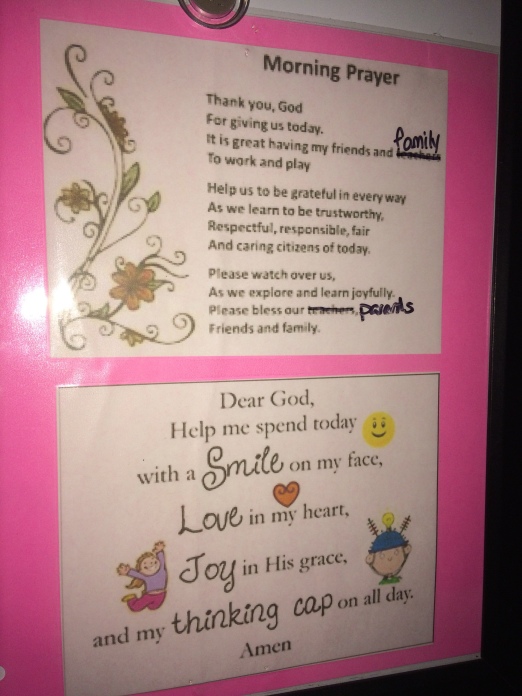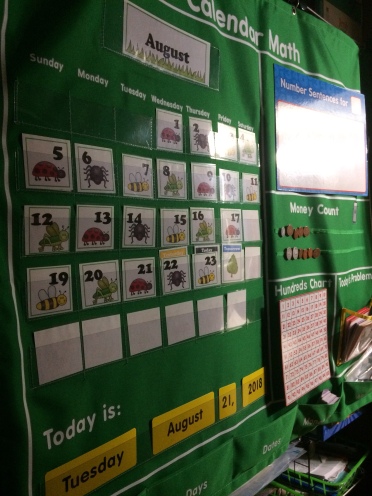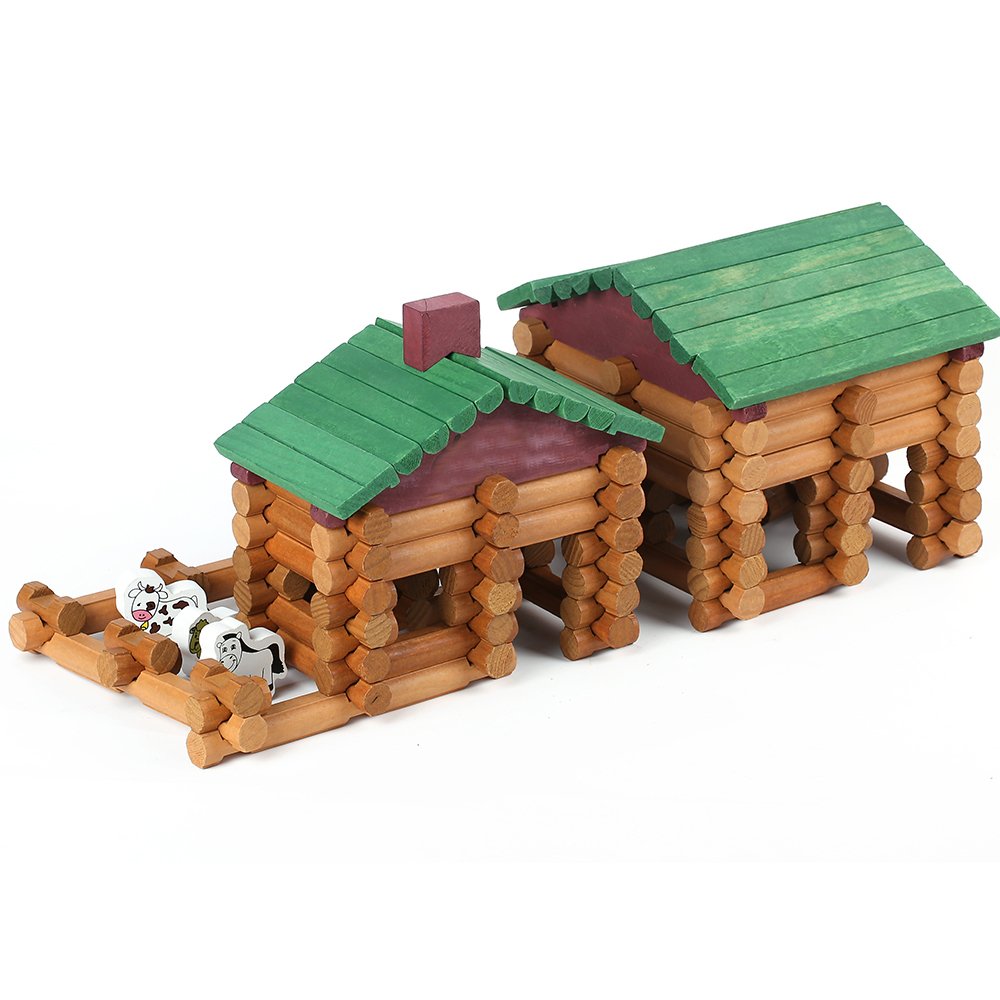**Although I try to provide as many FREE resources as possible this post may contain affiliate links alt no extra cost to you. We may earn a small commission, if a purchase is made through these links, which helps to support our blog and our family. Thank you!
Mornings:
We Start every morning off with our prayers and the Pledge of Allegiance. Below is a picture of the prayers that we say and a video of the Pledge of Allegiance.

Not the prettiest example but that’s what we’ve been using for the past few years.
Don’t have a flag? Grab one HEREand print it out to put up somewhere… you could even let the kids make a flag to proudly display. Amazon also has some little ones like this one HERE and HERE.
After this we have our calendar time also where we go over such things as the Days of the Week, the months, and some basic math.

This one came from Lakeshore Learning.
We also like to use this song during our ‘Morning Time’ to help the kids learn the 50 States.
Tip: If you want to go to a certain week/chapter or topic simply push the ‘ctrl’ and the ‘F’ button down together and a small bar will pop up. Type in the week number or chapter number you want and it will take you to it.
Week 3: Chapters 7, 8 & 9 (The Wolf-Pack, Two Stout Doors, A Fire In The Hearth)
Here is our lesson plan for the week:
Language Arts
Reading:
Read Chapters 7, 8 & 9
- You can read it or let the kids help to read it aloud.
- You can also access an audio version:
Discussion Questions:
Chapter Seven:
- How long did it take Pa and Mr. Edwards to build the stable?
- What wonderful thing did they find in the morning?
- Why did Pa come back home in a hurry?
- How did Pa get away from the wolves?
- What scary thing happened that night?
Chapter Eight:
- What did they see outside the next morning?
- What did Pa plan to make for the house? Why?
- What did he need? Did he let it stop him or did he find a way to get the job finished?
- What was Pa’s next project for the house?
Chapter Nine:
- What did Pa need to get for the fireplace?
- Describe the process that Pa used to build the fireplace.
- What did Ma put on the mantel?
- What did Pa warn Ma about?
Additional Reading:
Each child would complete a reading lesson from our McGuffey Primer Books or other reading materials that we chose for the day.
Younger kids will also be doing one lesson a day from Teach Your Child to Read in 100 Easy Lessons.
Vocabulary/Spelling:
Older Kids:
- Little House On The Prairie Adventure Week 3
- Write any words you mispelled 3 times each.
Parents click HERE for the answer key.**see instructions at the top of the page.
Younger Kids:
- Spelling You See Level A pages 14-18
Handwriting:
Using Spencerian Penmanship go over the instructions on p. 6
Writing:**
- Complete this worksheet HERE and use some of your vocabulary words for the bottom part.
- Practice brainstorming for upcoming reports with this worksheet HERE.
*Remember to use the thesaurus to come up with different words.
Other Activities:
Group:
- Read: Little Red Riding Hood
- Watch Signing Times: My First Signs
- Activity: Building Vocabulary Multiple Meanings Listening Pack
- Work on your Moby Max account
Older kids:
- Continue reading a book about Indians.
- Play Hangman
- Free Choice Spelling/Vocabulary Game
- Free Choice Activity
- Bonus Points: Read to a younger sibling
Younger kids:
- Work on a letter game.
- Watch the Rock N Learn Letter Sounds DVD.
- ABC Mouse
- Listening Center (Choose one book to read/listen to together)
- Cut N Paste worksheets
Math
You can work on a lesson in your Ray’s Arithmetic Books or other math workbook. (The lessons below reflect what we worked on.)
Group:
Rotate through these activities:
Older Kids:
- Study fractions
- Work on eighths, and ninths.
- Little House on the Prairie Fractions Week 3
- Beginning Fractions & Decimals by Rock ‘N Learn
- Bubble Pop! Math Challenge Games – Gr. 3‑4
- Work on Khan Academy
Younger Kids:
- Working on learning numbers 1-20.
- Work on your Math-U-See Primer: Lesson 14
- Continue to practice writing numbers 1-20. Click HERE for worksheets.
- Bubble Pop! Math Challenge Games – Gr. 1‑2
Geography and History
1. State Study
- This week we will study Rhode Island.
- Complete your notebooking pages.
- Older kids can write a report about the state.
- Play the The United States of America Puzzle
2. Research the Osage Indians
- Watch this video:
- Discuss what you learned.
- Write down 5 interesting facts.
Here is a video about some of the most famous Native Americans:
- Complete this lapbook piece HERE. Older kids can choose one chief to do more research on.
- Explore the Native Americans Resource Box from Lakeshore Learning
3. Continue to research Native American Indian Tribes
- Do some independent research.
- Here is an interesting video to watch also:
- Take notes about what you learned.
Extra:
Science
1. What are mules?
- Learn about mules and how they are different from horses.
- Mules are hybrids. Learn more about this here:
- Discuss what you learned.
- Name four ways that mules are different from horses.
- Name two more hybrid animals.
2. Continue to study Prairie Animals.
- Older kids can also work on a report. The report needs to include behavior, habitat, and diet.
- Discuss what you learned.
- Name one interesting fact about wolves that you didn’t know before.
Listen to these sounds:
- How would these sounds make you feel?
3. Why do animals eyes glow in the dark?
- Find out why animals eyes glow in the dark.
- Discuss what you have learned.
4. Continue learning about simple machines.
We will be using Explore Simple Machines!: With 25 Great Projects for this study.
What are screws?
- Read pages 46-52 of your book.
- Write down these words and their definitions:
- thread
- pitch
- design
- bolt
- worm gear
- spur gear
- drill bit
- What are some different ways that screws are used? How could these have helped Pa?
- Do one of the activities on pages 53-56.
Watch this video for more information:
- Discuss what you learned.
- Play Simple Machines Game
- Check out this video to see how this talented used screws to create pictures:
5. Research plants on the prairie.
We have been looking at prairie animals but what about the plants?
- Discuss what you have learned.
6. Constellations
- Discuss what you have learned.
- Check out these neat constellation cards on this page HERE. Look for ‘constellations.pdf’ under History and Geography.
- Or try this really neat craft HERE (I might try this with small flashlights.) or HERE.
Life Skills
1. Following Ma’s Example
House Cleaning Routine
Ma kept a neat and tidy home. They may not have had the nicest home, and we know from the story that they had dirt floors for a while, but it was always ‘pleasant’. Do you think that Ma had a cleaning routine? Do you remember her routine from the previous book we read?
Wash on Monday,
Iron on Tuesday,
Mend on Wednesday,
Churn on Thursday,
Clean on Friday,
Bake on Saturday,
Rest on Sunday
This is an example of a routine. Do you have a cleaning routine?
We have a daily, weekly, monthly and yearly routine that we use here. This is something that did take a little bit of work to put together and we are constantly tweaking it to fit our life.
Our daily cleaning routine includes things like making the beds, washing the dishes, cleaning the kitchen, cleaning the bathroom and laundry. We also make sure to sweep the floors, wipe the table and counters as well as to pick up our shoes and put away the toys throughout the day. This helps to keep our house neat and tidy.
We also have routines for things that need to get completed once or twice a week, once a month, and once a year. Our routines help keep everything running smoothly and help us to remember things that need done.
Here’s another video about routines:
- What routines do you have set in place to keep your home pleasant?
- Who is responsible for what?
- What things could you add to your cleaning routine?
FlyLady also has some great ideas to help you set up a cleaning routine that works for you and your family as well as other routines. She also has a ton of great tools on Amazon to help keep your house tidy and organized. We love to pair her tools with natural cleaners from Grove Collaborators.
2. Ways to help around the house like Laura
This week we are going to practice sweeping. Sweeping is probably one of the most frequently performed tasks. It needs to be done before mopping.
How to Sweep a floor:
- You need to get your broom and dustpan.
- Move things that can be moved like trash cans, rugs, etc. before sweeping.
- Start sweeping in one corner and work your way around the room.
- Sweep the dirt into piles.
- Check the piles for important things like coins and valuables.
- Sweep the piles into the dustpan.
- Empty the dustpan into the trashcan.
- Check the floor again for anything missed.
- Put back anything you moved to start with.
- Put the broom and dustpan back where you got them from.
Check out this video to see how to properly sweep a floor:
3. Character
We will be focusing on OBEDIENCE this unit. If you don’t have the book we used you can go HERE and download a lesson plan guide to use in your home.
Memorize: Children, obey your parents in everything, for this pleases the Lord. – Colossians 3:20
We will be studying obedience during this unit. What is obedience?
- Have you been praying for God’s help with being obedient?
- How have you done so far?
- Have you remembered to thank God for helping you?
Watch these videos about Moses:
- What did God ask Moses to do?
- Did Moses obey like Abraham? Why or why not?
- Did Moses want to obey? Did he obey?
- What happened because Moses obeyed God?
- We need to pray for obedient hearts that don’t argue back.
- Pray for help to obey even when you don’t want to obey.
‘Obedience is not always pleasant, but it is still very necessary. Obedience always brings a blessing.’
4.Manners
– Read through the next four pages of Emily’s Everyday Manners and discuss the manners shown in the pictures:
- Some manners get used a lot
- Some only get used once or twice
- Some are used only on special occasions
5. Memory Verse
We will be memorizing Psalm 8 during this unit study. Print it HERE.
- Work on memorizing a verse during the week for a special prize.
- Verse 3: When I consider thy heavens, the work of thy fingers, the moon and the stars, which thou hast ordained;
- Older kids can copy the memory verse down in their notebook.
6. Fun Activities
- See if you can get or borrow a sewing kit. Start practicing the sewing skills listed on pages 6-11 of My Little House Sewing Book.
- Play a fun board game like Checkers.
- Did you know that plants have feeling? Read about this in The Secret Life of Plants by Peter Tompkins and Christopher O. Bird.
7. Bonus Skills — Choose one or two to work on
Practice these until you finish this unit study and then we will move on to another new skill.
Kids Cook Real Food
-
Work on: Class 5 – Dry Beans, Rice (Beginner)
- Help to prepare a meal using your new skills.
Skill Trek:
- Work on at least one task a week.
- Practice your new skill this week.
Memorize the books of the Bible:
Learn about camping.
- Research about campfire safety.
- Write down these terms and what they mean:
- Tinder: Dry twigs, pine needles, pine cones and other flammable material that is not very thick
- Kindling: Small branches and materials for burning
- Fuel: Can range from branches or logs for keeping your fire burning
- Firebreak: a barrier of cleared ground to prevent the spread of the fire
Learn about Herbs.
- Did you know that herbs have stories written about them? These stories are called herbal lore.
- Read about the benefits of He Shou Wu in this article HERE.
- Read pages 31-37 of A Kid’s Herb Book: For Children of All Ages for another story.
- Research the following herbs:
- Write down the benefits and uses of each in your notebook.
- Did any of these surprise you? Which ones?
Goldenrod was mentioned in this section. Here is a quick video on its uses:
- Discuss what you learned.
- Be sure to jot down some notes.
PE, Health & Safety
1. Fireplace Safety
- The Ingalls’ family used their fireplace not only to cook but also to keep warm. This means it was essential to use almost everyday. They kids learned how to stay safe around the fireplace and you can too.
- Discuss what you have learned.
- List 5 things you should do to stay safe around a fireplace.
2. Heater Safety
- The Ingalls family used their fireplace to keep warm but many of us don’t have fireplaces. Sometimes people use heaters to keep warm. Let’s learn how to stay safe.
- Sometimes people use things like BBQ grills to heat their home when they can’t use a heater. Do you know why this can be dangerous?
- Discuss what you have learned.
- Make a safety checklist for heating your home.
3. Games/Outdoor Play
Laura enjoyed watching all of the animals on the prairie and mentioned the many different types of birds she saw. You can take turns naming the birds while playing this game.
- Play Birdie in the Air p. 93 of The Ultimate Homeschool Physical Education Game Book by Guy Bailey
- Play ‘Pop Goes The Weasel’. Click here if you need instructions.
Music, Arts & Crafts
You can find more Native American crafts and activities HERE , HERE, HERE and a FREE printable coloring book HERE.
Crafts:
- Build a log cabin with Lincoln Logs
- Make a Log Cabin Photo Frame p. 36 Pioneer Crafts for Kids
- Use My Book of Little House Paper Dolls: The Big Woods Collection to reenact and retell the story to someone.
- Make a Flower Mask p. 16 Pioneer Crafts for Kids
- Build a Pretzel Log Cabin

Art:
- Color some prairie flowers
- Draw a rock fireplace as Laura descibed it.
- Draw a log cabin.
Or you can try to draw a wolf:
Music:
Listen to the natural songs made by wolves:



